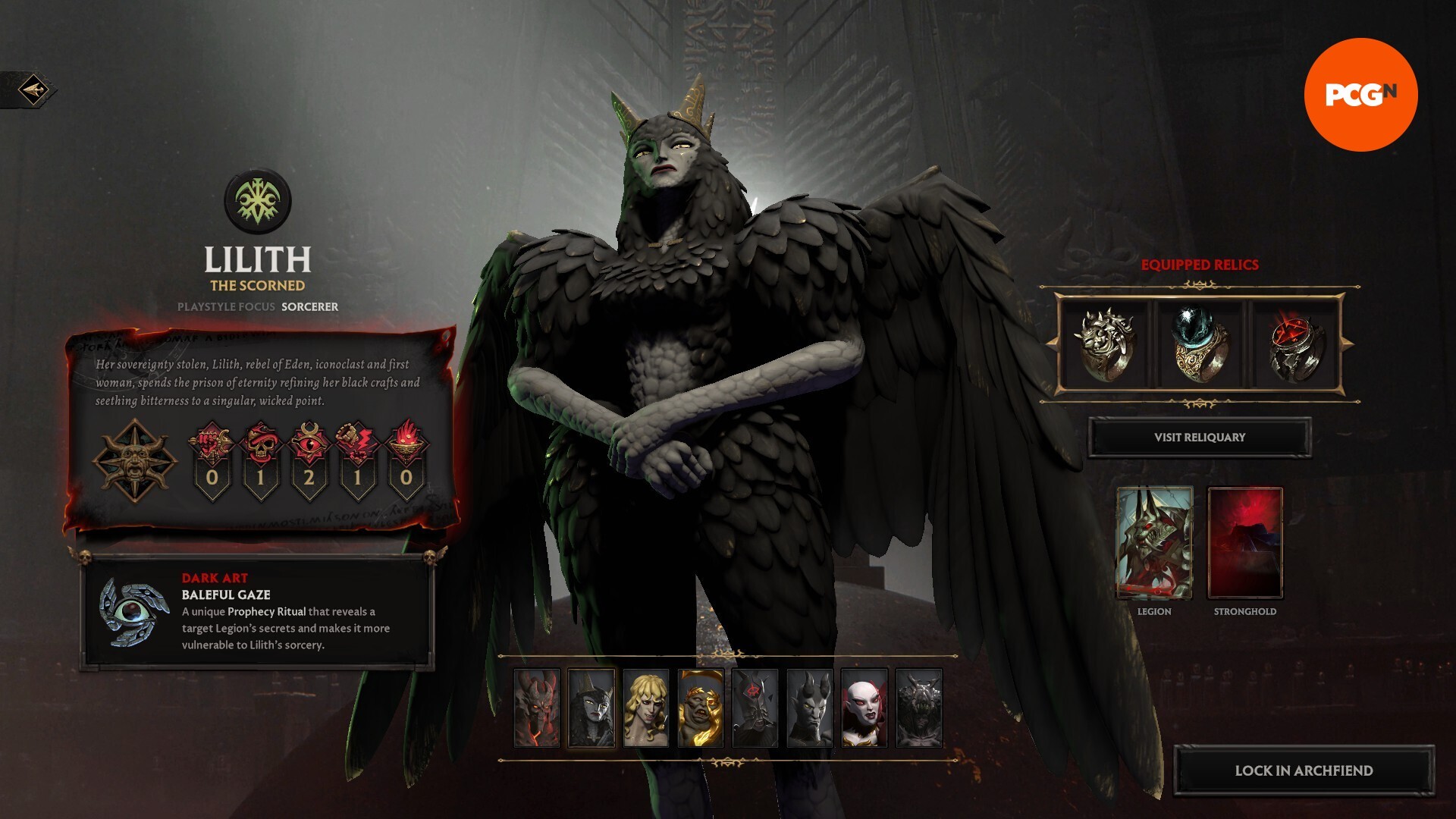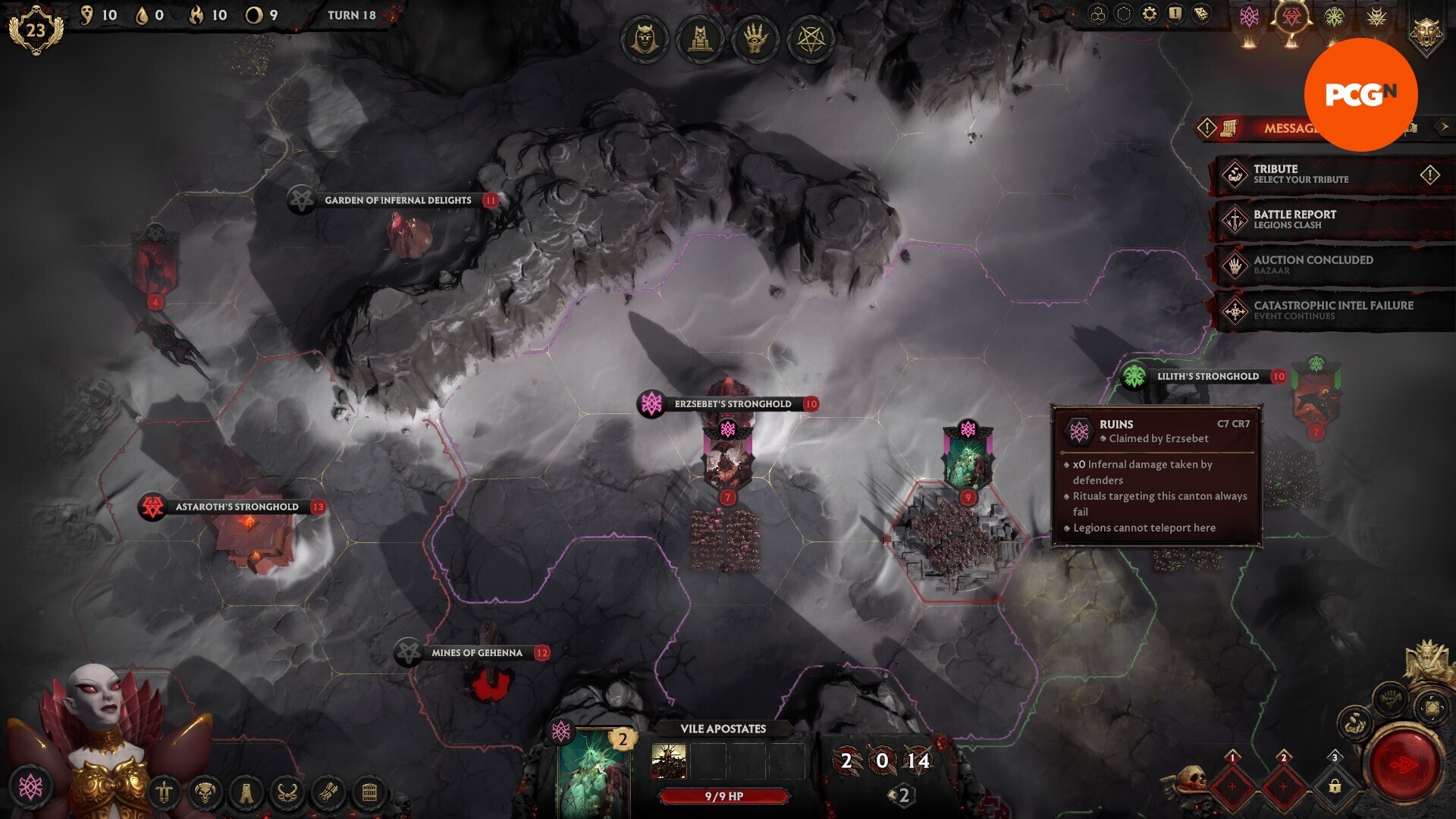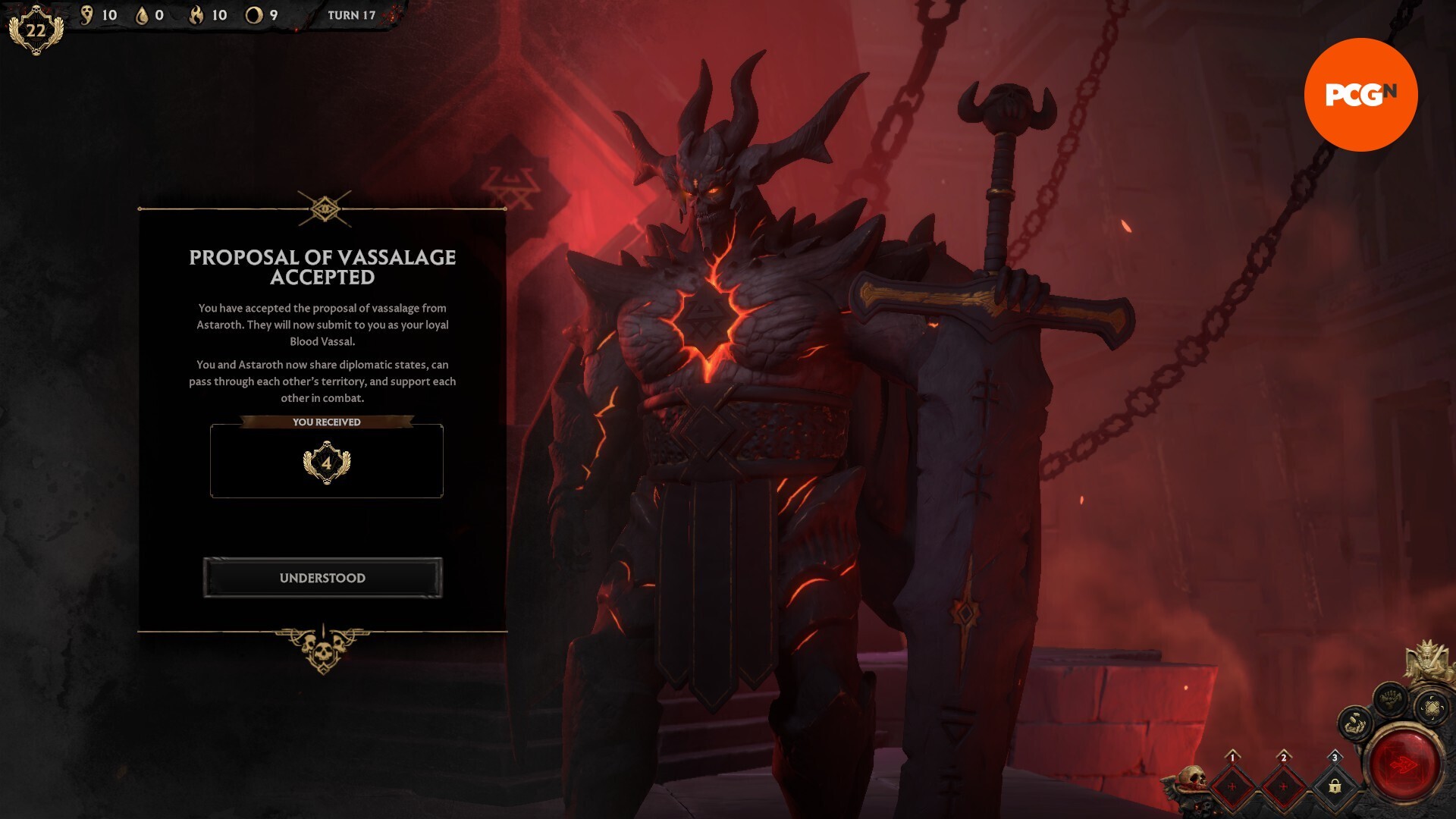Our Verdict
Solium Infernum regards strategy as a game of intellect, patience, and observation. Put into those terms, it might sound dry, but its visual flair combined with the ingenious ways it turns abstract ideas into tangible, comprehensible, and thrilling game mechanics make it irresistibly playable.
Every strategy game – or RTS, city builder, 4X, or management game – eventually destabilizes and malforms into an idle repetition of clicks. In the early game, your decisions feel crucial, tactile – with meager resources and a small, incipient society under your precarious control, diplomacy, the economy, the military, production, and culture and research must all be carefully steered. Civilization 6, Age of Empires, and Cities Skylines 2, for example, are their most interesting during this initial phase. But by the midgame and certainly towards the final third, you have created – due to these games’ focus on exponential, colonial growth – so many units, cities, construction projects, and frontlines that you detach from the intellectual or emotional possibilities of the strategy experience. You’ve disengaged from the intricacies or forensics of leadership. Your ‘strategy’ has blurred and bloated into an abstract, gamified generality – you don’t care about your cities or your people any more, only producing more soldiers, more research, more money, or whatever resource will most expeditiously achieve a victory condition.
Perhaps this is a suitable metaphor for the trappings and spiritual etiolation of power: the higher and longer you go, the less connected you become to the consequences of your decisions, and the effects of your rule at the micro scale. If that’s so, strategy and 4X games have, for the longest time now, excelled at articulating this particular tractate on the nature of civilization and its leaders. It’s time for something entirely different.
A new strategy game from Jumplight Odyssey creator League of Geeks, Solium Infernum is a unique interpretation of the genre in every sense. Aesthetically, mechanically, and narratively, Solium Infernum represents an upending of strategy and 4X traditions, an attempt to discover and amplify other aspects of one of the PC’s most popular game types. Strictly speaking, we have seen this before – Solium Infernum is a studio remake of the eponymous, 2009 cult classic designed by Victor Davis. But, although it retains many of the core elements of the underplayed original, League of Geeks’ version of Solium Infernum is simultaneously more in-depth and more accessible. The first time you try to play Solium Infernum you might feel intimidated, overwhelmed, or even frustrated by some of its more opaque conceits. But stay with it, and give yourself to the premise, and Solium Infernum becomes the most intuitive and immediately comprehensible strategy game of the last 20 years – if not longer.
The game takes place in a version of Hell largely inspired by religious paintings, Dante’s Divine Comedy, and Paradise Lost by Henry Milton. The Dark Lord, Hell’s ruler, has abandoned the infernal throne and disappeared. In his absence, you choose from one of eight Solium Infernum archfiends, powerful aristocrats that maneuver Hell’s twisted society on their venal, covetous whims. They each have their own strengths – Astaroth, the general, is a master of military might, and his units command more attack power, whereas Belial, the liar, is a Machiavellian crook who may easily draw opponents into deceptive alliances, the better to backstab them later.
All of these prospective new rulers are bound however to the Infernal Conclave, Hell’s fickle, and intensely bureaucratic parliament that governs territory, edicts, the distribution of souls (used as currency), and virtually every other aspect of infernal politics. One method of victory is to court the Conclave’s favor, earn a significant amount of ‘prestige,’ and be elected leader above all the other archfiends. Otherwise, conquest is not the goal in Solium Infernum – you don’t win just because you have the largest number of military units, the most land, or the most money. Victory comes by way of wits and manipulation, and there is no such thing as an idle turn.
For the majority of your games in Solium Infernum, you will command two, maybe three military units. That’s it. If they’re killed in battle, you can bid on replacements at Hell’s bazaar. Likewise, you can strengthen your existing troops with mercenary praetors, or stat-boosting artifacts, manuscripts, and rituals. Everything in Solium Infernum costs souls, which come in the form of tribute collected by your minions, but there’s no production or economy as such – each turn, you can instruct your underlings to collect you some souls, or the Conclave, in its infinite caprice, might decide to hand you some. You don’t build anything – no roads, monuments, granaries, barracks, World Wonders, or missile bases – and you don’t advance through different historical eras. Turns are limited (initially at least) to two instructions – if you tell a unit to move, that’s one, and if you order your subordinates to fetch tribute, that’s another – and the map, at least on default settings, is small enough that you can practically see it all on your screen at once. Forget size. Forget scale. Forget mass production, global warfare, and centuries-long technology trees. Solium Infernum is a strategy game at the most psychological level, an intimate battle of seemingly small and slow-burn decisions that gradually have bigger and bigger repercussions. You don’t skip a turn just to rush your new tank army. You don’t play a card just to see what happens. Everything – every single thing – you do in Solium Infernum has significance.
For example, I’m playing as Andromalius, the intensely vain fallen angel possessed by their own ego. My plan is twofold. Before we begin, I choose from the Solium Infernum relics – items that provide game-long bonuses and status effects – that allows for something called ‘Power Behind The Throne.’ If I court the favor of one of my rival archfiends, make myself their vassal, and guide them to an election victory, when the Conclave proclaims them the new ruler, all of their prestige will transfer to me – they will think they’ve won, but the throne will actually become mine. None of the other archfiends know I have this relic. So, I access the diplomacy screen and send an emissary to Mammon, offering an armistice. Some turns later, Mammon insults Murmur in front of the Conclave, beginning a vendetta between them. Hoping to make Mammon my puppet, I insult Murmur also. My false solidarity seems to have the desired effect, and Mammon offers to share some of his tribute with me.
And so I begin the second part of my plan, to earn prestige by embarrassing my third rival, the ever-spiteful Erzsebet. Knowing her pride, I publicly demand she pay me a handful of tribute. She refuses, and we enter a vendetta. If she destroys one of my legions in three turns, she earns a chunk of my prestige; if I destroy one of hers, I get some of her prestige. Deliberately, I have kept my armies weak. But I enter the bazaar and recruit a praetor named Eligos. In the same turn, I secretly cast a ritual which, when deployed, significantly weakens the strength of an opposing unit in combat. Predictably, Erzsebet storms into my territory. Our legions line up. I summon Eligos to the frontline. And I cast my ritual. The self-proclaimed princess of Hell has fallen right into my trap. And then I’m suddenly attacked from behind, and my entire legion is destroyed in a single encounter. I forgot that I had insulted Murmur.
Such is the intricacy of Solium Infernum’s own style of strategy. You don’t need to fight or build. You can win the entire game simply through the genius of your machinations. In one instance, I declare to the Conclave that I intend to find the scattered pages of a forgotten arcane manuscript, and cast its dark magic. Impressed, they promise me an additional 30 prestige should I accomplish my scheme, which will move me considerably closer to an election victory. Two turns later, the same Conclave proclaims a moratorium on the collection of earthly souls, effectively freezing the collection of all forms of tribute – and any efforts to discover missing manuscripts. In one of my greatest successes to date, I accumulate sufficient prestige to increase my infernal rank to that of a marquex. At the same time, I repeatedly provoke Lilith, my rival, into a series of territorial skirmishes, and demand that she pay reparative tribute, knowing, of course, that she won’t. In front of the Conclave, she is perceived as a warmonger and a narcissist. When they vote to have her excommunicated, my position as marquex means that my ballot counts for three, and I gleefully seal her fate with a slip of parchment.
There are other ways to win Solium Infernum. If you can marshall sufficient legions to capture all your archfiends’ strongholds and places of power, and convince the Conclave to allow you to wage such a bloody campaign, then you can claim victory through sheer force. Likewise, you can occupy Hell’s capital, Pandaemonium. Hold it for a sufficient number of turns and the throne is yours. But Solium Infernum is better enjoyed as a sly, cruel, backstabbing fiend simulator. Again, this is a strategy game where every single legion, piece of currency, diplomatic action, prestige point, choice, offer, refusal, and turn has considerable consequences. I am so bored of clicking through dozens upon dozens of buildings and armies that I don’t even know I’ve created, just waiting for the ‘culture’ bar to hit the next milestone, or the technology to unlock that gets me closer to a space victory. Solium Infernum makes all other strategy games feel significantly less strategic. Between the military, the economy, the politics, the emotions, and the psychology, you’re working with everything here – you need a strategy for everything.
And it looks fantastic. The designs of the archfiends ooze malice, sin, and sleaze, while the maps are unlike anything you’ve seen in any recent strategy game rivals – the verdant meadows and bountiful oceans of a Civilization or Age of Empires are replaced with claustrophobic fire-and-brimstone confines of a classical vision of Hell. The soundtrack is deep and ominous, occasionally swelling into a groaning, demonic chorus, and there’s a dark affection for Milton’s literary style. The archfiends use an obscure arcane language, but in-game descriptions and loading screens are written like passages from Paradise Lost or Revelations. It might sound superficial, but Solium Infernum is at its best and most unique when you start to roleplay its vainglorious protagonists. The aesthetic puts you in the mindset of a paranoid, power-hungry demon.
Likewise, the long-form, asynchronous multiplayer. If you set up a game against your friends, you can log in, input your turn, then log out for two days while the rest of the group responds. It’s great if you’re time-poor but still want a lengthy, multiplayer strategy game. More importantly, it creates these wonderful deliberation and machination periods, where you’re all silently chewing on your next scheme in the days between turns. The magic of Solium Infernum happens in between rounds. Even when you’re away from your PC, you’re still playing it in your head.
Nevertheless, despite all the ways it encourages you to design and deliberate your own evil plots, Solium Infernum suffers from the same prescriptivity of its genre peers. Especially given their respective strengths and weaknesses, even before you choose your archfiend, you need to decide a specific strategy, and then follow it for essentially the entire game. Experimentation is often dangerous – if you want to be successful, you need to decide on a victory type before you start and throw all of your efforts behind it. The endgame also becomes a little confused. For the most part, Solium Infernum does a terrific job of reducing the bloat and the detritus of other strategy games – there are no unnecessary units. But in the final ten turns, you will find yourself hitting the skip button, and watching your own and other archfiends’ legions walk back and forth around the map, idly taking up time. Fortunately, you can customize the game length. The best option is a ‘short’ 40-turn match.
Accepting those problems, Solium Infernum remains the best new strategy game I’ve played in years. Where the genre typically focuses on cruder, easier-to-quantify interpretations of the word – sheer military might, raw economic volume – Solium Infernum regards strategy as a game of intellect, patience, and observation. Put into those terms, it might almost sound dry, but its visual flair and dark sense of humor, combined with the ingenious ways that it turns abstract ideas like betrayal into tangible, comprehensible, and thrilling game mechanics, make it irresistibly playable.
Aim and shoot. Select and attack. Click and move. In so many games, we perform dramatically inert, emotionally and intellectually neutral ‘inputs.’ We just do stuff for a while. In Solium Infernum, that never happens. It’s a cliche I’ve heard across generations of videogames: ‘everything you do matters.’ Solium Infernum comes closer to making that actually true than anything else I’ve played in a very long time.







